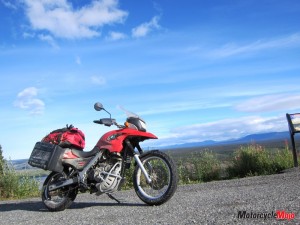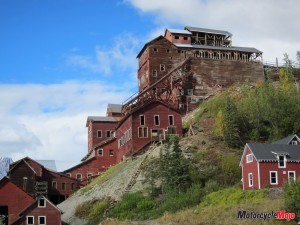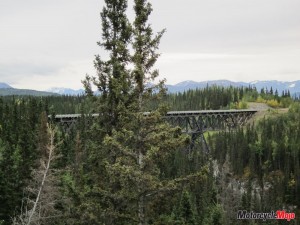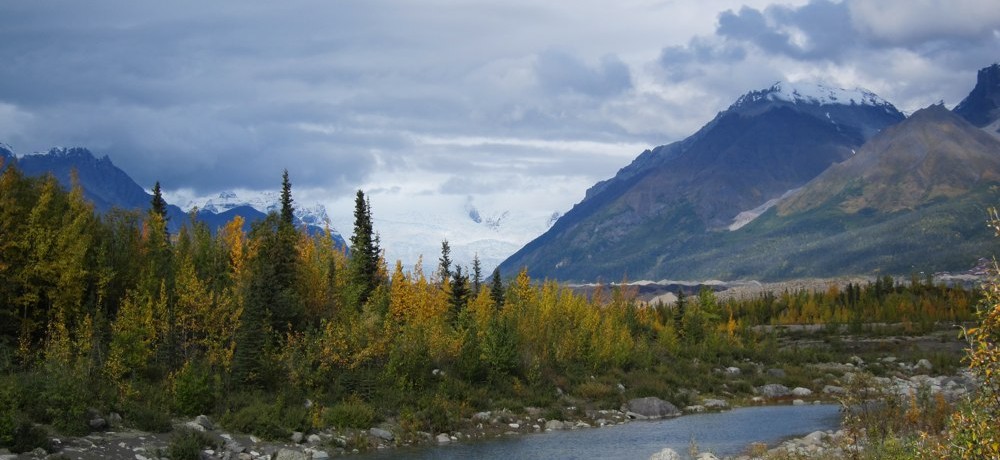The boom and bust of industry leave their ghosts in the wilds of Alaska
Rain, mud, sleet and snow had dogged us as we headed north on the Dalton Highway. Ice blurred my vision and I was covered in frozen mud. I was wearing all the clothes I had, but I was still shivering. The cold forced us to turn back at the Arctic Circle. Any plans to dip our tires in the Arctic Ocean at Prudhoe Bay faded with the worsening weather and a forecast of heavy snow.
 I had flown into Anchorage for my Alaskan adventure at the end of the summer, hoping to miss the tourists and particularly the herds of recreational vehicles that plague the summer roads. Also, with the cold winter (not sure if Alaska has a fall season) creeping in, the mosquitoes and other bugs had disappeared into hibernation. I rented a BMW F650GS from Nancy and Keith at Alaska Motorcycle Adventures, dropped some personal things into the hard-plastic side bags, strapped my supposedly waterproof duffel bag on the back and headed to Chicken, AK, for a rendezvous with friends who had trucked their KLRs to Alberta before heading up the Alaska Highway.
I had flown into Anchorage for my Alaskan adventure at the end of the summer, hoping to miss the tourists and particularly the herds of recreational vehicles that plague the summer roads. Also, with the cold winter (not sure if Alaska has a fall season) creeping in, the mosquitoes and other bugs had disappeared into hibernation. I rented a BMW F650GS from Nancy and Keith at Alaska Motorcycle Adventures, dropped some personal things into the hard-plastic side bags, strapped my supposedly waterproof duffel bag on the back and headed to Chicken, AK, for a rendezvous with friends who had trucked their KLRs to Alberta before heading up the Alaska Highway.
After the Alaskan weather had stopped us cold on our northern route, we turned south and parted ways in Fairbanks, allowing me to explore on my own. Farther south at Denali National Park I hung a left, and with fleeting glimpses of Mount McKinley through the fog in the rearview mirror, headed east on the Denali Highway for the ghost towns of McCarthy and Kennecott.
Making Tracks
The town of Kennecott and its mine sat atop one of the largest copper deposits ever found. The story is told that when the copper ran out in the 1930s, the miners dropped their tools where they stood and left on one of the last trains to Chitina, leaving the mining town of Kennecott, along with its Wild West neighbour, McCarthy, abandoned overnight. The tracks were torn up behind them and Mother Nature took over.
 While researching this trip, I was unable to find a single rider who had been to Alaska and visited these ghost towns. Keith at Adventure Motorcycling knew the place and warned about the difficult road, the lack of gas available on the route, the primitive camping and the need to be on the lookout for big four-legged road obstructions. Nancy had given me a can of bear spray as a parting gift, which was not to leave my side when camping alone in the Alaskan wilderness. Most importantly, my food was to be placed into a bear hang every night, and heeding Nancy’s warnings, I slept with the can of bear spray in my hand.
While researching this trip, I was unable to find a single rider who had been to Alaska and visited these ghost towns. Keith at Adventure Motorcycling knew the place and warned about the difficult road, the lack of gas available on the route, the primitive camping and the need to be on the lookout for big four-legged road obstructions. Nancy had given me a can of bear spray as a parting gift, which was not to leave my side when camping alone in the Alaskan wilderness. Most importantly, my food was to be placed into a bear hang every night, and heeding Nancy’s warnings, I slept with the can of bear spray in my hand.
Not only did I have to contend with the washed-out gravel and mud road, rain and cold, but also the first weekend of moose hunting season. Dodging
bullets (I could only hope that the shots I would periodically hear were not aimed my way), pickup trucks with rifles in the back window with a moose strapped to the hood and crazy, drunken four-wheeler riders (also armed), I managed to avoid becoming a trophy or hood ornament – and I thought it was the wild animals in Alaska that I needed to look out for!
With the sun peeking out from behind the clouds for what seemed to be the first time in a week, riding south on Richardson Highway in the direction of Valdez, I turned east onto the
Edgerton Highway (Alaska Route 10) and headed to the small, resurrected ghost town of Chitina – abandoned from the 1940s to the 1970s, but now boasts a population of 105 – where I was planning to pick up gas for the push into the wild. The paved, twisty scenic road was made for motorcycling with its wide sweepers, steep grades, wonderful views of the Wrangell Mountains, the Copper River and its bluffs, and, at this time of the year, almost no traffic. But the only gas stop in Chitina was closed for the season, so I got to ride that 104 km round trip again to fill up with gas at the highway junction.
Dumb Luck
Exiting Chitina to the east is the McCarthy Road, highly recommended for adventure drivers of both the four- and two-wheel variety. It had been raining hard for days, exposing sharp rocks, imbedded railroad rails and ties, major soft spots (quicksand in Alaska?), potholes that could swallow the small, narrow front wheel of my rented BMW F650GS and ridiculous washboards that actually resulted in a chipped tooth. A flat tire was more than a remote possibility, and I was a bit concerned that I was not carrying a spare. It was just dumb luck that I never needed one. I did, however, run into an issue with mud from my front tire coating the radiator, causing the bike to overheat. I had to stop a number of times, using my canteen to wash out the dried mud caked into the radiator fins. The roads were rough enough at the end of the season followed by weeks of rain, but attempts to improve things by piling loose, crushed stone in the bad spots made it even more difficult to keep the bike up in deep, soft and wet gravel. I did have to use all my experience to keep upright and even learned some new tricks.
 Everything was going fairly well until I reached the former railroad bridge (built in 1910 and supposedly rehabilitated) dangling high over the Kuskulana River. I’m afraid of heights, so I spent a lot of time inspecting that bridge, pretending to take photos as I gathered my courage. Focused on a point straight across the single-lane trestle, perched 68 metres above the gorge and resisting the urge to look over the low wooden guardrails, which would not have stopped a bike tipping over the side, I rode the 160 metres of wood planks to the other side. The relief I felt was comforting but short lived, as I quickly realized there was only one way back.
Everything was going fairly well until I reached the former railroad bridge (built in 1910 and supposedly rehabilitated) dangling high over the Kuskulana River. I’m afraid of heights, so I spent a lot of time inspecting that bridge, pretending to take photos as I gathered my courage. Focused on a point straight across the single-lane trestle, perched 68 metres above the gorge and resisting the urge to look over the low wooden guardrails, which would not have stopped a bike tipping over the side, I rode the 160 metres of wood planks to the other side. The relief I felt was comforting but short lived, as I quickly realized there was only one way back.
After several hours of fantastic but rough riding on 95 gruelling but exhilarating kilomteres, I finally reached the wilderness base campsite on the shores of the Kennicott River, with McCarthy just a few kilometres away.
I toured through McCarthy, population reported as 28 in the 2010 census, but up to 58 when I visited. During the mining era, alcohol and prostitution were outlawed in the nearby company-controlled mining town of Kennecott, so McCarthy became the place to partake of illicit activities for the bored miners. When the railway reached the town in 1911, it prospered, even boasting amenities such as a hospital, school, gymnasium, and of course saloons, restaurants, hotels and a very busy red-light district. But the copper ran out in 1938 and the town was more or less abandoned until the 1970s (around the time the Trans-Alaska pipeline was constructed). In the 1980s, the towns of McCarthy and Kennecott, as well as the nearby mines, were protected within the Wrangell-St. Elias National Park. The area became a National Historic Landmark in 1986, and the National Park Service is attempting to stabilize many of the structures at the mine and in the towns.
You’re not alone
Wandering through the silent streets of McCarthy, I could sense the ghosts of the people who had lived, worked and died there: storekeepers, miners, bartenders and prostitutes walking alongside me as I passed the old, faded buildings. Shivers ran down my spine while passing the spot where, in 1983, eight of the 22 residents were gunned down in an ill-conceived plan to stop the Alaskan pipeline. The killer was sentenced to 634 years in prison. On the 7 km muddy, potholed road to the mines and dodging a number of unleashed dogs, I passed locals doing a brisk business ferrying tourists from McCarthy to Kennecott on their four-wheelers. The mines were spectacular.
Great wooden structures with faded red paint hung on the side of Bonanza Ridge, overlooking the magnificent scenery of the rocky Kennicott Glacier moraine (an early misspelling had the town and mine named Kennecott, while the river and glacier are called Kennicott). The concentration mill was 14 stories high, with other buildings representing power plants, machine shops, offices, bunkhouses and even a hospital, as well as many more old but wonderful buildings required to extract and process copper from the richest-known concentration in the world. This massive undertaking created major political battles, with the conservationists fighting those with a financial interest in the mines. The mining community won, no doubt helped by the resources provided by two major owners, the Guggenheim family and J. P. Morgan. In 1916 alone, the local mines extracted $32 million of copper ore.
Running on Fumes
Back to McCarthy and over the footbridge to base camp, where I had to figure out a way to get back to the highway with less than half a tank of gas. I was advised to visit the rather odd fellow managing the camp, who lived in an old trailer in the woods, because he periodically trucked in containers of gas for his truck and ATV. He grudgingly gave me a gallon of his precious fuel for $25. It was the most expensive gas I had ever purchased, but I was very happy to get it. On the way back, while stopped alongside the road taking photos of the river, a park ranger pulled up and asked if I needed fuel. It seems that a motorcycle running out of gas is a common occurrence on this route. On my return to the dreaded high trestle bridge over the river gorge, my nerves were as frayed as the first trip, but the outcome was thankfully the same.
My relief almost turned to horror only five minutes later, however, when I rounded a blind corner and just about ran into a moose. I quickly stopped, dismounted and, as she ambled off the road, took a photo as proof. I crossed the Chitina bridge and made it back onto pavement as the day was getting cold and it was starting to rain again. Luckily, I had noticed a great campsite at the Liberty Falls State Recreation Site on the way in. Camping on a wooden platform right beside the rapids of Liberty Creek, I took heed of the warnings to beware of both black and grizzly bears. After a restful night and a deposit into the honour box for the night’s campsite, I was off to explore more of the great back roads of Alaska.

































